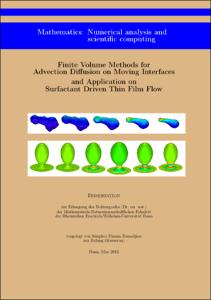Finite Volume Methods for Advection Diffusion on Moving Interfaces and Application on Surfactant Driven Thin Film Flow

Finite Volume Methods for Advection Diffusion on Moving Interfaces and Application on Surfactant Driven Thin Film Flow

| dc.contributor.advisor | Rumpf, Martin | |
| dc.contributor.author | Nemadjieu, Simplice Firmin | |
| dc.date.accessioned | 2020-04-18T16:06:23Z | |
| dc.date.available | 2020-04-18T16:06:23Z | |
| dc.date.issued | 04.01.2013 | |
| dc.identifier.uri | https://hdl.handle.net/20.500.11811/5604 | |
| dc.description.abstract | The thesis is divided into two parts. First, we present two finite volumes schemes for the discretization of convection-diffusion-reaction problems on moving surfaces. The first scheme extends the two point flux approximation finite volumes on moving surfaces. The second scheme presents a finite volume scheme of type O-method. Here, we construct around the mesh vertices a linear approximation of the solution to the given problem using the unknowns located at cells' centers. A suitable flux continuity on cells interfaces in incorporated. The method allows also the construction a second order upwind for convection operators; which makes the overall scheme second order in space. Next, we model the flow of a surfactant driven thin-film. Here, the use of tensor theory combined with lubrication approximation helps to reduce the Navier-Stokes equations describing the flow of the thin-film in three dimensions to a fourth order equation stated on the moving curved surface whose unknown is the film height. The surfactant, assumed to be insoluble, is modeled by a convection-diffusion equation on the fluid-air interface. We simulate the coupled system using an interface tracking method derived from the above defined finite volumes schemes. Several examples are computed to present the effectiveness and the accuracy of the methods. | en |
| dc.description.abstract | Cette thèse est scindée en deux parties. Dans un premier temps, nous présentons deux schémas volumes finis pour la discrétisation des problèmes de diffusion-convection-réaction sur les surfaces mouvantes. Le premier schéma présente une extension du schéma volumes finis avec flux à deux points sur les surfaces mouvantes. Le deuxième développe une méthode de type O-méthode. Cette dernière consiste à construire à partir des inconnus au centre des mailles, des solutions linéaires autour des nœuds de maillage qui intègrent la continuité des flux aux interfaces de mailles. La méthode permet aussi la construction des décentrages amont d'ordre 2 et ainsi, offre au procédé l'ordre 2 de convergence sur tout maillage non dégénéré. Ensuite, nous modélisons l'écoulement du couplage filme mince-surfactant (surface active agent) sur les surfaces mouvantes et simulons à l'aide des schémas volumes finis précédemment définis. Ici, l'utilisation du calcul tensoriel et de la méthode d'approximation par la lubrification permettent de réduire les équations de Navier-Stokes caractérisant le mouvement du filme mince en dimension 3 en un système d'équations définies sur la surface courbe mouvante dont l'inconnu est la hauteur du fluide. Le surfactant supposé insoluble est modélisé par une équation de diffusion convection à la l'interface fluid-air. Nous simulons l'ensemble en utilisant une méthode dite de capture d'interface (Interface tracking method) dérivée des volumes finis définis plus haut. Plusieurs exemples illustrent à suffisance l'efficacité et la précision des différentes méthodes. | en |
| dc.language.iso | eng | |
| dc.rights | In Copyright | |
| dc.rights.uri | http://rightsstatements.org/vocab/InC/1.0/ | |
| dc.subject | Numerical analysis | |
| dc.subject | finites volumes | |
| dc.subject | moving mesh | |
| dc.subject | interface tracking method | |
| dc.subject | O-method | |
| dc.subject | higher order upwind | |
| dc.subject | fluid mechanics | |
| dc.subject | thin-film | |
| dc.subject | surfactant | |
| dc.subject | lubrication approximation | |
| dc.subject.ddc | 510 Mathematik | |
| dc.title | Finite Volume Methods for Advection Diffusion on Moving Interfaces and Application on Surfactant Driven Thin Film Flow | |
| dc.type | Dissertation oder Habilitation | |
| dc.publisher.name | Universitäts- und Landesbibliothek Bonn | |
| dc.publisher.location | Bonn | |
| dc.rights.accessRights | openAccess | |
| dc.identifier.urn | https://nbn-resolving.org/urn:nbn:de:hbz:5n-30919 | |
| ulbbn.pubtype | Erstveröffentlichung | |
| ulbbnediss.affiliation.name | Rheinische Friedrich-Wilhelms-Universität Bonn | |
| ulbbnediss.affiliation.location | Bonn | |
| ulbbnediss.thesis.level | Dissertation | |
| ulbbnediss.dissID | 3091 | |
| ulbbnediss.date.accepted | 12.07.2012 | |
| ulbbnediss.institute | Mathematisch-Naturwissenschaftliche Fakultät : Fachgruppe Mathematik / Institut für Numerische Simulation (INS) | |
| ulbbnediss.fakultaet | Mathematisch-Naturwissenschaftliche Fakultät | |
| dc.contributor.coReferee | Eymard, Robert |
Files in this item
This item appears in the following Collection(s)
-
E-Dissertationen (4337)




